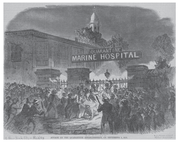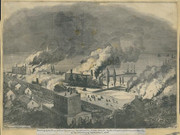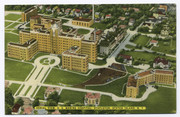Stapleton - pre-FDNY fire history - "How A 19th Century Mob Of Arsonists Burned Down Staten Island?s Quarantine Hospital"
- phillipe martin chatelain 12/03/2013 Architecture, New York
On the night of Sept. 1 1858, a mob of villagers stormed the grounds of the quarantine station on Staten Island and set fire to almost all of the buildings in the hospital complex.
In 1858, before Staten Island consolidated with the rest of New York City, the New York Marine Hospital housed around 1,500 persons suffering from infectious diseases. The practice of medicine was in a less sophisticated state and in the 19th century this was the City?s best defense against new diseases, such as smallpox, cholera, typhus and yellow fever. While quarantine is a practice that strictly limits the civil and human rights of an otherwise ?free? person, the architecture of the City?s many islands reflect this once mainstream practice. On September 1, 1858 the site was burned down in a mob protest that stemmed from community outrage about the hazards of housing a quarantine hospital of this scale in what was essentially their backyards.

Opened in 1799, the NY Marine Hospital which became known solely as the ?Quarantine,? was located in the Tompkinsville section of Staten Island. This island in New York Harbor was pushing 20,000 residents in a landmass of roughly three times the size of Manhattan?which had 630,000 residents. It was a mass of farmland, with various communities located on the northeastern shore. The Quarantine was accessible primarily by steamboat, and was fortified by six-foot-tall brick walls on all sides.
The New York Harbor at this time was a place of new beginnings, as the immigrant population was booming. Foreign-born settlers with their sights on New York City carried with them all their belongings and, perhaps unknowingly, new infectious diseases. According to the Public Health Chronicles, many of these new immigrants arrived sick with one of the diseases common to sea travelers in the 19th century. Vessels entering New York Harbor were vigorously inspected. All it took was a single passenger or crew member with an infectious disease for an arriving ship to be redirected from the docks of Brooklyn or Manhattan to the piers of the Quarantine.
The Quarantine became somewhat of a prison to the sick, who were ?laid in wagons by the boatmen? and brought to the appropriate hospitals, while the rest ?although healthy, were kept in hospital quarters for observation.? It was a major enterprise, and the Quarantine expenses and salaries were paid for by the hefty taxes imposed on the vessels that used the port??$2 for each cabin passenger and $0.50 for each traveler in steerage?? today worth about $61 and $15 respectively.
After an 1848 yellow fever outbreak in the neighboring Staten Island communities, opposition to the Quarantine kept building grew. The perception among Staten Islanders at the time was that if not for the Quarantine, there would be virtually no disease on the Island at all. Staten Islanders were convinced that illness came to their towns in two ways. One theory was that diseases were blown by the wind from infected vessels anchored offshore? Locals were also convinced that infectious diseases were carried into the community by Quarantine staff [who] reside in the village.
On September 1, 1858, thirty men approached and ransacked the establishment, which had relatively low occupancy for the night (some assume that administrators were aware of the impending attack). The hospital staff, at first scrambling to release the animals and rescue patients, were confused to find that they had all been moved. As the mob made its way around the Quarantine grounds, setting new fires, it had swelled to several hundred people. The mob resolved to return the next day to ?celebrate? the burning of the Quarantine Hospital, which resulted in the burning of any remaining buildings.

Astoundingly, only two people died in the whole ordeal. One man was killed by a Quarantine worker who took the opportunity to settle an old score. Another died of yellow fever.
The organizers, Ray Tompkins and John C. Thompson, who were charged for the arson of the former Marine Hospital were acquitted of all charges by Judge Henry B. Metcalfe (himself a Staten Island man who argued for the removal of the Quarantine in 1849).
https://untappedcities.com/2013/12/03/how-19th-century-mob-of-arsonists-burned-down-staten-islands-quarantine-hospital/
Note - The Qurantine's services were transferred to a new facility built in Stapleton under the US Marine Hospital Service, which later became the US Public Health Service. The hospital was sold to the Sisters of Charity and was run as a private hospital, Bayley Seton Hospital, 1980-2002. It is now abandoned.

https://abandonednyc.com/tag/bayley-seton-hospital/
- phillipe martin chatelain 12/03/2013 Architecture, New York
On the night of Sept. 1 1858, a mob of villagers stormed the grounds of the quarantine station on Staten Island and set fire to almost all of the buildings in the hospital complex.
In 1858, before Staten Island consolidated with the rest of New York City, the New York Marine Hospital housed around 1,500 persons suffering from infectious diseases. The practice of medicine was in a less sophisticated state and in the 19th century this was the City?s best defense against new diseases, such as smallpox, cholera, typhus and yellow fever. While quarantine is a practice that strictly limits the civil and human rights of an otherwise ?free? person, the architecture of the City?s many islands reflect this once mainstream practice. On September 1, 1858 the site was burned down in a mob protest that stemmed from community outrage about the hazards of housing a quarantine hospital of this scale in what was essentially their backyards.

Opened in 1799, the NY Marine Hospital which became known solely as the ?Quarantine,? was located in the Tompkinsville section of Staten Island. This island in New York Harbor was pushing 20,000 residents in a landmass of roughly three times the size of Manhattan?which had 630,000 residents. It was a mass of farmland, with various communities located on the northeastern shore. The Quarantine was accessible primarily by steamboat, and was fortified by six-foot-tall brick walls on all sides.
The New York Harbor at this time was a place of new beginnings, as the immigrant population was booming. Foreign-born settlers with their sights on New York City carried with them all their belongings and, perhaps unknowingly, new infectious diseases. According to the Public Health Chronicles, many of these new immigrants arrived sick with one of the diseases common to sea travelers in the 19th century. Vessels entering New York Harbor were vigorously inspected. All it took was a single passenger or crew member with an infectious disease for an arriving ship to be redirected from the docks of Brooklyn or Manhattan to the piers of the Quarantine.
The Quarantine became somewhat of a prison to the sick, who were ?laid in wagons by the boatmen? and brought to the appropriate hospitals, while the rest ?although healthy, were kept in hospital quarters for observation.? It was a major enterprise, and the Quarantine expenses and salaries were paid for by the hefty taxes imposed on the vessels that used the port??$2 for each cabin passenger and $0.50 for each traveler in steerage?? today worth about $61 and $15 respectively.
After an 1848 yellow fever outbreak in the neighboring Staten Island communities, opposition to the Quarantine kept building grew. The perception among Staten Islanders at the time was that if not for the Quarantine, there would be virtually no disease on the Island at all. Staten Islanders were convinced that illness came to their towns in two ways. One theory was that diseases were blown by the wind from infected vessels anchored offshore? Locals were also convinced that infectious diseases were carried into the community by Quarantine staff [who] reside in the village.
On September 1, 1858, thirty men approached and ransacked the establishment, which had relatively low occupancy for the night (some assume that administrators were aware of the impending attack). The hospital staff, at first scrambling to release the animals and rescue patients, were confused to find that they had all been moved. As the mob made its way around the Quarantine grounds, setting new fires, it had swelled to several hundred people. The mob resolved to return the next day to ?celebrate? the burning of the Quarantine Hospital, which resulted in the burning of any remaining buildings.

Astoundingly, only two people died in the whole ordeal. One man was killed by a Quarantine worker who took the opportunity to settle an old score. Another died of yellow fever.
The organizers, Ray Tompkins and John C. Thompson, who were charged for the arson of the former Marine Hospital were acquitted of all charges by Judge Henry B. Metcalfe (himself a Staten Island man who argued for the removal of the Quarantine in 1849).
https://untappedcities.com/2013/12/03/how-19th-century-mob-of-arsonists-burned-down-staten-islands-quarantine-hospital/
Note - The Qurantine's services were transferred to a new facility built in Stapleton under the US Marine Hospital Service, which later became the US Public Health Service. The hospital was sold to the Sisters of Charity and was run as a private hospital, Bayley Seton Hospital, 1980-2002. It is now abandoned.

https://abandonednyc.com/tag/bayley-seton-hospital/



























































































































